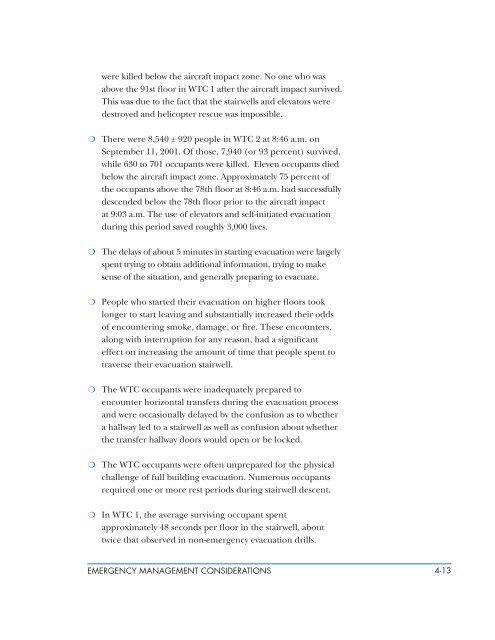FEMA 453 Design Guidance for Shelters and Safe Rooms
FEMA 453 Design Guidance for Shelters and Safe Rooms
FEMA 453 Design Guidance for Shelters and Safe Rooms
You also want an ePaper? Increase the reach of your titles
YUMPU automatically turns print PDFs into web optimized ePapers that Google loves.
were killed below the aircraft impact zone. No one who was<br />
above the 91st floor in WTC 1 after the aircraft impact survived.<br />
This was due to the fact that the stairwells <strong>and</strong> elevators were<br />
destroyed <strong>and</strong> helicopter rescue was impossible.<br />
m There were 8,540 ± 920 people in WTC 2 at 8:46 a.m. on<br />
September 11, 2001. Of those, 7,940 (or 93 percent) survived,<br />
while 630 to 701 occupants were killed. Eleven occupants died<br />
below the aircraft impact zone. Approximately 75 percent of<br />
the occupants above the 78th floor at 8:46 a.m. had successfully<br />
descended below the 78th floor prior to the aircraft impact<br />
at 9:03 a.m. The use of elevators <strong>and</strong> self-initiated evacuation<br />
during this period saved roughly 3,000 lives.<br />
m The delays of about 5 minutes in starting evacuation were largely<br />
spent trying to obtain additional in<strong>for</strong>mation, trying to make<br />
sense of the situation, <strong>and</strong> generally preparing to evacuate.<br />
m People who started their evacuation on higher floors took<br />
longer to start leaving <strong>and</strong> substantially increased their odds<br />
of encountering smoke, damage, or fire. These encounters,<br />
along with interruption <strong>for</strong> any reason, had a significant<br />
effect on increasing the amount of time that people spent to<br />
traverse their evacuation stairwell.<br />
m The WTC occupants were inadequately prepared to<br />
encounter horizontal transfers during the evacuation process<br />
<strong>and</strong> were occasionally delayed by the confusion as to whether<br />
a hallway led to a stairwell as well as confusion about whether<br />
the transfer hallway doors would open or be locked.<br />
m The WTC occupants were often unprepared <strong>for</strong> the physical<br />
challenge of full building evacuation. Numerous occupants<br />
required one or more rest periods during stairwell descent.<br />
m In WTC 1, the average surviving occupant spent<br />
approximately 48 seconds per floor in the stairwell, about<br />
twice that observed in non-emergency evacuation drills.<br />
EmErgEncy managEmEnt considErations<br />
4- 3

















